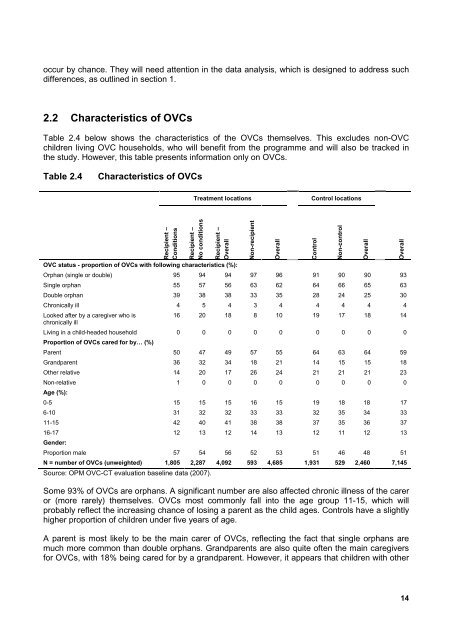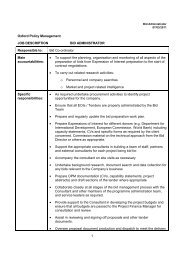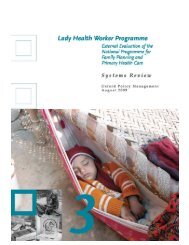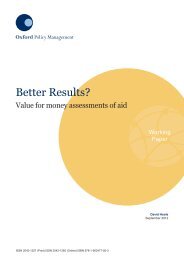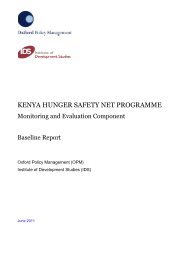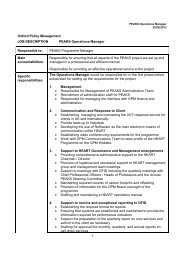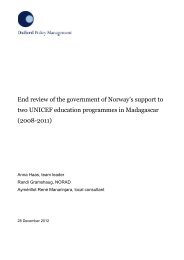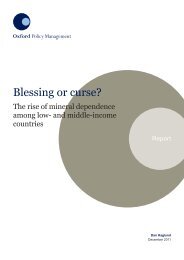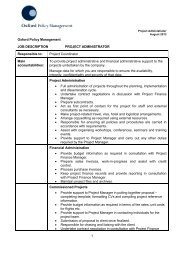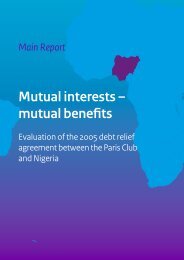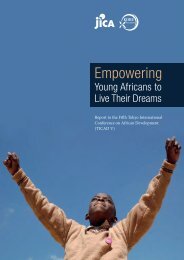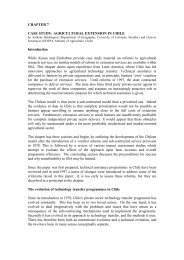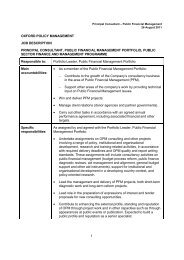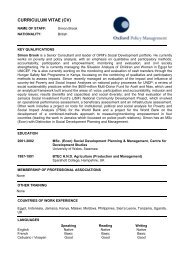Kenya OVC-CT Programme Operational and Impact Evaluation
Kenya OVC-CT Programme Operational and Impact Evaluation
Kenya OVC-CT Programme Operational and Impact Evaluation
You also want an ePaper? Increase the reach of your titles
YUMPU automatically turns print PDFs into web optimized ePapers that Google loves.
occur by chance. They will need attention in the data analysis, which is designed to address suchdifferences, as outlined in section 1.2.2 Characteristics of <strong>OVC</strong>sTable 2.4 below shows the characteristics of the <strong>OVC</strong>s themselves. This excludes non-<strong>OVC</strong>children living <strong>OVC</strong> households, who will benefit from the programme <strong>and</strong> will also be tracked inthe study. However, this table presents information only on <strong>OVC</strong>s.Table 2.4Characteristics of <strong>OVC</strong>sTreatment locationsControl locationsRecipient –ConditionsRecipient –No conditionsRecipient –Overall<strong>OVC</strong> status - proportion of <strong>OVC</strong>s with following characteristics (%):Orphan (single or double) 95 94 94 97 96 91 90 90 93Single orphan 55 57 56 63 62 64 66 65 63Double orphan 39 38 38 33 35 28 24 25 30Chronically ill 4 5 4 3 4 4 4 4 4Looked after by a caregiver who ischronically illNon-recipientOverall16 20 18 8 10 19 17 18 14Living in a child-headed household 0 0 0 0 0 0 0 0 0Proportion of <strong>OVC</strong>s cared for by… (%)Parent 50 47 49 57 55 64 63 64 59Gr<strong>and</strong>parent 36 32 34 18 21 14 15 15 18Other relative 14 20 17 26 24 21 21 21 23Non-relative 1 0 0 0 0 0 0 0 0Age (%):0-5 15 15 15 16 15 19 18 18 176-10 31 32 32 33 33 32 35 34 3311-15 42 40 41 38 38 37 35 36 3716-17 12 13 12 14 13 12 11 12 13Gender:Proportion male 57 54 56 52 53 51 46 48 51N = number of <strong>OVC</strong>s (unweighted) 1,805 2,287 4,092 593 4,685 1,931 529 2,460 7,145Source: OPM <strong>OVC</strong>-<strong>CT</strong> evaluation baseline data (2007).ControlNon-controlOverallOverallSome 93% of <strong>OVC</strong>s are orphans. A significant number are also affected chronic illness of the careror (more rarely) themselves. <strong>OVC</strong>s most commonly fall into the age group 11-15, which willprobably reflect the increasing chance of losing a parent as the child ages. Controls have a slightlyhigher proportion of children under five years of age.A parent is most likely to be the main carer of <strong>OVC</strong>s, reflecting the fact that single orphans aremuch more common than double orphans. Gr<strong>and</strong>parents are also quite often the main caregiversfor <strong>OVC</strong>s, with 18% being cared for by a gr<strong>and</strong>parent. However, it appears that children with other14


